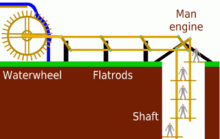Michael Loam | |
|---|---|
| Born | 1 November 1797 |
| Died | 14 July 1871 (aged 73) Botusfleming, Cornwall, England |
| Occupation | Engineer |
| Engineering career | |
| Discipline | Civil |
| Projects | First man engine in the UK |
Michael Loam (1 November 1797 – 14 July 1871) was an English engineer who introduced the first man engine (a device to carry men up and down the shaft of a mine) into the UK.[1]
In 1834, concerned for the health of miners and for the loss in profits incurred by their long, slow climbs by ladders, the Royal Cornwall Polytechnic Society announced a prize for the design of a better system of transporting miners in and out of the deep mines in the county. Michael Loam won this prize in 1841 for his man engine, despite evidence that it was already in use in the Hartz Mountains in Germany.[2]
Inspired by the German designs and constructed of a series of moving platforms, the first man engine was installed in 1842 at Tresavean Mine—one of the deepest in Cornwall at the time.[2] Its adoption was encouraged by the mine's owner, John Rogers.
Loam was trained as an engineer at Wheal Abraham by Arthur Woolf.[3] He remained active in the metal mining and smelting industries in Cornwall and is noted as an investor in the Tamar Tin Smelting Company in 1863.[4]

- ^ "Image of Michael Loam, English Engineer and Inventor, 1853". Science & Society Picture Library. Retrieved 15 October 2011.
- ^ a b Schwartz, Sharron; Parker, Roger (1998). Lanner: A Cornish Mining Parish. Tiverton: Halsgrove. pp. 93–4. ISBN 1-84114-019-8.
- ^ ODNB - E. I. Carlyle, ‘Woolf, Arthur (bap. 1766, d. 1837)’, rev. Philip Payton, Oxford Dictionary of National Biography, Oxford University Press, 2004 accessed 20 Aug 2006
- ^ D.B. Barton A History of Tin Mining and Smelting in Cornwall; 2nd edn (1969, reprinted 1989); Cornwall Books ISBN 1-871060-03-6